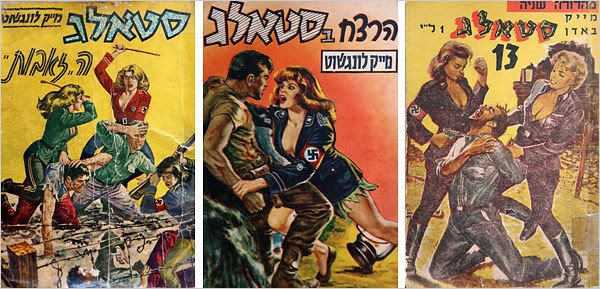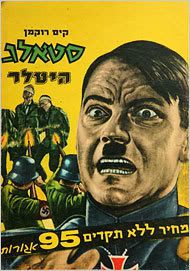
JERUSALEM, Sept. 5 — It was one of Israel’s dirty little secrets. In the early 1960s, as Israelis were being exposed for the first time to the shocking testimonies of Holocaust survivors at the trial of Adolf Eichmann, a series of pornographic pocket books called Stalags, based on Nazi themes, became best sellers throughout the land.
Read under the table by a generation of pubescent Israelis, often the children of survivors, the Stalags were named for the World War II prisoner-of-war camps in which they were set. The books told perverse tales of captured American or British pilots being abused by sadistic female SS officers outfitted with whips and boots. The plot usually ended with the male protagonists taking revenge, by raping and killing their tormentors.
After decades in dusty back rooms and closets, the Stalags, a peculiar Hebrew concoction of Nazism, sex and violence, are re-emerging in the public eye. And with them comes a rekindled debate on the cultural representation here of Nazism and the Holocaust, and whether they have been unduly mixed in with a kind of sexual perversion and voyeurism that has permeated even the school curriculum.
“I realized that the first Holocaust pictures I saw, as one who grew up here, were of naked women,” said Ari Libsker, whose documentary film “Stalags: Holocaust and Pornography in Israel” had its premiere at the Jerusalem Film Festival in July and is to be broadcast in October and shown in movie theaters. “We were in elementary school,” he noted. “I remember how embarrassed we were.”
Hanna Yablonka, a professor of history at Ben-Gurion University of the Negev, says the film highlights what she calls the “yellow aspects of nurturing the memory of the Holocaust.”
“Are we taking it into the realm of semipornography?” she asked. “The answer is, we are.”
The Stalags were practically the only pornography available in the Israeli society of the early 1960s, which was almost puritanical. They faded out almost as suddenly as they had appeared. Two years after the first edition was snatched up from kiosks around the central bus station in Tel Aviv, an Israeli court found the publishers guilty of disseminating pornography. The most famous Stalag, “I Was Colonel Schultz’s Private Bitch,” was deemed to have crossed all the lines of acceptability, prompting the police to try to hunt every copy down.
The Stalags went out of print and underground, circulating in specialty secondhand bookstores and among furtive groups of collectors.
Mr. Libsker’s 60-minute documentary puts the Stalags under a spotlight for the first time and exposes some uncomfortable truths. One is that the Stalags were a distinctly Israeli genre, created by Israeli publishers and penned by Israeli authors, although they had masqueraded as translations from English and were written in the first person as if they were genuine memoirs.
Until the Eichmann trial began in 1961, the voices of the Holocaust had hardly been heard in Israel. The survivors sensed the ambivalence of the old-timers who blamed them for not having emigrated in time, and questioned what immoral deeds they might have done in order to stay alive.
In the movie, the publisher of the first Stalag, Ezra Narkis, acknowledges that it was the trial, in all its sensational and often gory detail, that gave momentum to the genre.
More provocatively, the movie contends that Stalag pornography was but a popular extension of the writings of K. Tzetnik, the first author to tell the story of Auschwitz in Hebrew and a hero of the mainstream Holocaust literary canon. K. Tzetnik “opened the door,” and “the Stalag writers learned a lot from him,” Mr. Narkis said.
K. Tzetnik was a pseudonym for Yehiel Feiner De-Nur. The alias, short for the German for concentration camper, was meant to represent all survivors, a kind of Holocaust everyman. One of K. Tzetnik’s biggest literary successes, “Doll’s House,” published in 1953, told the story of a character purporting to be the author’s sister, serving the SS as a sex slave in Block 24, the notorious Pleasure Block in Auschwitz.
Though a Holocaust classic, many scholars now describe it as pornographic and likely made up.
"It was fiction," said Na'ama Shik, a researcher at Yad Vashem, The Holocaust Martyrs' and Heroes' Remembrance Authority. "There were no Jewish whores in Auschwitz."
Yet “Doll’s House” and other writings of K. Tzetnik, who died in 2001, are treated as historical fact by many in Israel, and are included in the high school curriculum. Mr. Libsker’s movie shows the vice principal of an Israeli school guiding a group of teenagers through Auschwitz, pointing out Block 24 and quoting from K. Tzetnik.
This approach to Holocaust education is being eschewed by an increasing number of Israeli academics. “The Holocaust was bad enough, without making things up,” Dr. Yablonka said.
Sidra Ezrahi, a professor of comparative Jewish literature at the Hebrew University of Jerusalem, said, “His books were so graphic and so barbaric.” Maybe at first they had an important impact, she said. “But over time,” she added, “if this is what they have chosen to leave in the Israeli curriculum, it’s a scandal.”
For many Israelis, the most dramatic part of the Eichmann trial was the testimony of K. Tzetnik. His true identity was revealed for the first time on the witness stand, where he passed out. Simultaneously, the Stalags were reaching the peak of their commercial success.
Yechiel Szeintuch, a professor of Yiddish literature at the Hebrew University, rejects any link between the smutty Stalags and the writings of K. Tzetnik as “an original sin.” He insists K. Tzetnik’s work was based on reality.
But Mr. Libsker, 35, himself the grandson of Holocaust survivors, contends that it is the same mixture of “horror, sadism and pornography” that serves to perpetuate the memory of the Holocaust in the Israeli consciousness to this day.

No comments:
Post a Comment